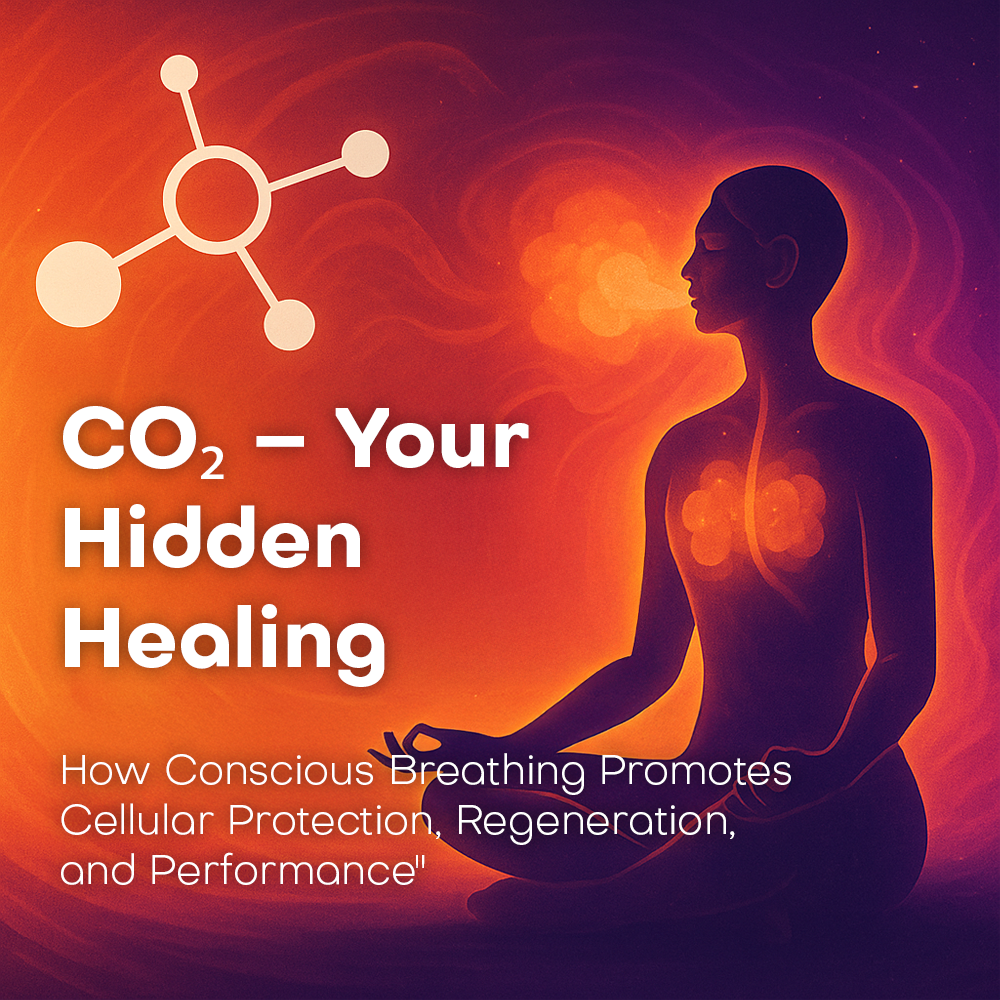CO2 - Your Hidden Healing

August 14, 2025
The Science Behind Breathing Techniques, CO₂, and Regenerative Health
In a world dominated by high-tech medicine and expensive supplements, one biological key remains largely overlooked: carbon dioxide (CO₂). Yet modern research shows that controlled breathing techniques and a targeted increase in CO₂ levels can trigger astonishing effects — from cellular repair to the reduction of oxidative stress.
🧪 CO₂ as Natural Cellular Protection: The Biochemical Evidence
1. CO₂ as an Antioxidant (Veselá & Wilhelm, 2002)
- CO₂ neutralizes peroxynitrite (ONOO⁻), which would otherwise cause aggressive nitration of proteins and DNA. Instead, harmless substances such as nitrate or carbonate are formed.
- It protects key enzymes such as superoxide dismutase (SOD) from oxidative damage caused by hydrogen peroxide (H₂O₂).
Conclusion: CO₂ acts as a natural free radical scavenger and reduces oxidative stress at the cellular level.
Sources: PubMed, ResearchGate, Wiley, CiteSeer
2. Carboxytherapy & CO₂ Exposure (MDPI, Springer)
- In oxygen-deprived tissues, elevated CO₂ levels stimulate wound healing.
- Reduce ROS (reactive oxygen species).
- Lower inflammation markers and improve capillary blood flow.
Relevance: CO₂ is also used in medical therapies as a regenerative biological stimulus.
Sources: International Journal of Molecular Sciences, SpringerLink
3. CO₂ and the Cellular Redox System
- CO₂ supports endogenous antioxidant systems, e.g. by stabilizing metal complexes (iron, copper).
- Prevents Fenton reactions (radical chain reactions).
- Acts synergistically with glutathione, SOD, and catalase.
Conclusion: CO₂ is part of a complex protective system that promotes cellular homeostasis.
🔄 The Most Effective Breathing Techniques for Increasing CO₂ and Promoting Cellular Regeneration
🌄 Wim Hof Method
- 30 deep breaths + breath-holding (after exhalation).
- Goal: CO₂ build-up, stress resilience, immune modulation.
- Science: Kox et al., 2014 (PNAS)
🧡 Tony Robbins’ Priming
- 3×30 rapid nasal breaths.
- Goal: Energization, CO₂ kickstart.
- Basis: Pranayama + neuropsychology
💪 Box Breathing (Navy SEALs)
- 4:4:4:4 or 6:6:6:6 (inhale-hold-exhale-hold).
- Goal: CO₂ stability, nervous system regulation.
- Origin: Tactical breathing training
🔵 Weißwasser / Buteyko Method
- Slow nasal breathing + breath-holds.
- Goal: Reduced breathlessness, increased CO₂ tolerance.
- Use case: Chronic illness, sleep disorders
🎓 Andrew Huberman – Physiological Sigh
- 2 quick inhales + long exhale.
- Goal: Immediate stress reduction.
- Basis: Stanford University, Neuroscience
📊 Wissenschaftlich belegte Effekte von CO₂ im Körper
| Effect | Scientific Evidence |
|---|---|
| Neutralization of ONOO⁻ | Veselá & Wilhelm (PubMed, 2002) |
| Protection of antioxidant enzymes | MDPI, Wiley Online, PubMed |
| Reduction of ROS in tissues | Carboxytherapy studies (MDPI, Springer) |
| Improved blood circulation | AMPK/NO pathways in CO₂ therapy |
| Cellular respiration & mitochondrial efficiency | JBC, ResearchGate, 2022 |
Conclusion: 5 Tibetans + CO₂ = Biological Upgrade
The combination of movement, breathing technique, and conscious elevation of CO₂ is not an esoteric concept — it’s biological intelligence. The “5 Tibetans+” unite proven exercises with modern respiratory science. Every human carries this tool within. You just need to use it.
“Breath is medicine. CO₂ is the carrier.”




